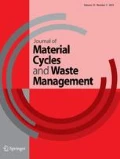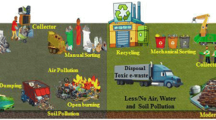Abstract
The disposal, recycling, and part salvaging of discarded electronic devices such as computers, printers, televisions, and toys are now creating a new set of waste problems. This study is aimed at identifying the sources and quantifying the pollution levels generated from electronic waste (e-waste) activities at Guiyu, Guangdong Province, China, and their potential impacts on the environment and human health. The preliminary results indicate that total polycyclic aromatic hydrocarbons (PAHs) in soil obtained from a printer roller dump site was 593 µg/kg dry weight (dry wt.) and in sediment from a duck pond, the PAH concentration was 514 µg/kg (dry wt.). Sediment from the Lianjiang River was found to be contaminated by polychlorinated biphenyls (743 µg/kg) at a level approaching three times the Canadian Environmental Quality Guidelines probable effect level of 277 µg/kg. Total mono- to hepta-brominated diphenyl ether homologue concentrations (1140 and 1169 µg/kg dry wt.) in soils near dumping sites were approximately 10–60 times those reported for other polybrominated diphenyl ether-contaminated locations in the world. In-house study on the open burning of cable wires showed extremely high levels of polychlorinated dibenzo-p-dioxins and dibenzofurans resulting in 12419 ng toxic equivalents (TEQ)/kg of waste input and 15 610 ng TEQ/kg for two separate tests, respectively, which were about three orders of magnitude higher than those for the open burning of household waste. High levels of Cu (712, 528, and 496 mg/kg), exceeding the new Dutch list action value, were determined for soil near the printer roller dumping area, sediment from Lianjiang River, and soil from a plastic burn site, respectively. A more thorough study is underway to elucidate the extent of contamination of toxic pollutants in different ecological compartments to establish whether these pollutants are bioaccumulated and biomagnified through food chains. Assessments of human health impacts from oral intake, inhalation, and dermal contact will be subsequently investigated.
Similar content being viewed by others
Change history
01 September 2006
The data on PCDD/F emissions appearing in the Abstract and in the Results and discussion section titled “Polychlorinated dibenzo-p-dioxins and dibenzofurans as a result of open burning” on pages 21 and 29, respectively, of Vol. 8 (2006), No.1, were published as a result of miscommunication and with insufficient attribution. The original source and correct concentrations can be found in an article by Brian K. Gullet, William P. Linak, Abderrahmane Touati, Shirley J. Wasson, Staci Gatica, and Charles K. King, to be published in the Journal of Material Cycles and Waste Management, Vol. 9 (2007), No. 1.
References
InstitutionalAuthorNameNational Safety Council (1999) Electronic product recovery and recycling baseline report NSD Washington, DC
UNEP DEWA/GRID-Europe (2005) Chapter 5: E-waste, the hidden side of IT equipment's manufacturing and use. In: Early warning on emerging environmental threats. www.grid.unep.ch
BAN and SVTC – The Basel Action Network and Silicon Valley Toxics Coalition (2002) Exporting harm: the high-tech trashing of asia. February 25, 2002, Seattle WA, USA. www.ban.org
South China Morning Post Magazine (2002) Ghost in the machines. South China Morning Post, May 12, 2002
Y Liang MH Wong RBE Shutes DM Revitt (1999) ArticleTitleEcological risk assessment of polychlorinated biphenyl contamination in the Mai Po marshes nature reserve, Hong Kong Water Res 33 1337–1346 Occurrence Handle1:CAS:528:DyaK1MXitlehtrw%3D
HY Zhou RYH Cheung MH Wong (1999) ArticleTitleBioaccumulation of organochlorines in freshwater fish with different feeding modes cultured in treated wastewater Water Res 34 2905–2914
HY Zhou MH Wong (2000) ArticleTitleAccumulation of sediment-sorbed PCBs in tilapia Water Res 34 2905–2914 Occurrence Handle1:CAS:528:DC%2BD3cXktFWksrg%3D
HY Zhou MH Wong (2000) ArticleTitleMercury accumulation in freshwater fish with emphasis on the dietary influence Water Res 34 4234–4242 Occurrence Handle1:CAS:528:DC%2BD3cXntFCrsr0%3D
Wong MH, Poon BHT (2003) Sources, fates and effects of persistent organic pollutants in China, with emphasis on the Pearl River Delta. In: Fielder H (ed) Persistent organic pollutants, The handbook of environmental chemistry, Vol. 3, Part O, Springer-Verlag, Berlin, pp. 355–369
CKC Wong KM Leung BHT Poon CY Lan MH Wong (2002) ArticleTitleOrganochlorine hydrocarbons in human breast milk collected in Hong Kong and Guangzhou Arch Environ Contam Toxicol 43 364–372 Occurrence Handle10.1007/s00244-002-1210-7 Occurrence Handle1:CAS:528:DC%2BD38XnvFCmurg%3D
USEPA (1996) Method 3540C revision 3, soxhlet extraction. www.epa.gov/epaoswer/hazwaste/test/main.htm
USEPA (1996) Method 3660B revision 2, sulfur cleanup. www.epa.gov/epaoswer/hazwaste/test/main.htm
USEPA (1996) Method 3620B revision 2, florisil cleanup. www.epa.gov/epaoswer/hazwaste/test/main.htm
USEPA (1996) Method 8270C revision 3, semivolatile organic compounds by gas chromatography/mass spectrometry (GC/MS). www.epa.gov/epaoswer/hazwaste/test/main.htm
DL Wang ZW Cai GB Jiang A Leung MH Wong WK Wong (2005) ArticleTitleDetermination of polybrominated diphenyl ethers in soil and sediment from an electronic waste recycling facility Chemo-sphere 60 810–816 Occurrence Handle1:CAS:528:DC%2BD2MXlvVWntr8%3D
DL Wang ZW Cai GB Jiang MH Wong WK Wong (2005) ArticleTitleGas chromatography/ion trap mass spectrometry applied for the determination of polybrominated diphenyl ethers in soil Rapid Commun Mass Spectrom 19 83–89 Occurrence Handle1:CAS:528:DC%2BD2MXhtFChtbg%3D
USEPA (1994) Method 3051 revision 0. Microwave-assisted acid digestion of sediments, sludges, soils, and oils. www.epa.gov/epaoswer/hazwaste/test/main.htm
KC Ho YL Chow JT Yau (2003) ArticleTitleChemical and microbiological qualities of The East River (Dongjiang) water, with particular reference to drinking water supply in Hong Kong Chemosphere 52 1441–1450 Occurrence Handle10.1016/S0045-6535(03)00481-8 Occurrence Handle1:CAS:528:DC%2BD3sXlsVWksbw%3D
HS Hong WQ Chen L Xu XH Wang LP Zhang (1999) ArticleTitleDistribution and fate of organochlorine pollutants in the Pearl River Estuary Mar Pollut Bull 39 376–382 Occurrence Handle1:CAS:528:DyaK1MXntFSisLY%3D
MP Zakaria H Takada S Tsutsumi K Ohno J Yamada E Kouno H Kumata (2002) ArticleTitleDistribution of polycyclic aromatic hydrocarbons (PAHs) in rivers and estuaries in Malaysia: a widespread input of petrogenic PAHs Environ Sci Technol 36 1907–1918 Occurrence Handle10.1021/es011278+ Occurrence Handle1:CAS:528:DC%2BD38XisVOhtbY%3D
VROM (1994) Intervention values and target values: soil quality standards; Netherlands Ministry of Housing, Spatial Planning and Environment, Department of Soil Protection, The Hague, Netherlands
Swedish EPA (2002) Assessment of contamination level. www.internat.naturvardsverket.se/
TC Van Brummelen RA Verweij SA Wedzinga CAM Van Gestel (1996) ArticleTitleEnrichment of polycyclic aromatic hydrocarbons in forest soil near a blast furnace plant Chemosphere 32 293–314 Occurrence Handle1:CAS:528:DyaK28XovVyhtA%3D%3D
Bakker MI, Baars AJ, Baumann RA, Boon PE, Hoogerbrugge R (2003) Indicator PCBs in foodstuffs: occurrence and dietary intake in The Netherlands at the end of the 20th century. RIVM report 639102025/2003, RIKILT report 2003.014. Inspectorate for Health Protection, Account Food, Ministry of Health, Welfare and Sports. The Netherlands
CCME (Canadian Council of Ministers of the Environment) (2003) Canadian environmental quality guidelines. Summary table, December 2003. www.ec.gc.ca/ceqg-rcqe/English/ceqg/default.cfm
ER Long DD MacDonald SL Smith FD Calder (1995) ArticleTitleIncidence of adverse biological effects within ranges of chemical concentration in marine and estuary sediments Environ Manag 19 81–97
DW Connell RSS Wu BJ Richardson K Leung PSK Lam PA Connell (1998) ArticleTitleFate and risk evaluation of persistent organic contamination and related compounds in Victoria Harbour, Hong Kong Chemosphere 36 2019–2030 Occurrence Handle10.1016/S0045-6535(97)10087-X Occurrence Handle1:CAS:528:DyaK1cXhslahtrY%3D
Y Xing YL Lu RW Dawson YJ Shi H Zhang TY Wang WB Liu HC Ren (2005) ArticleTitleA spatial temporal assessment of pollutions from PCBs in China Chemosphere 60 731–739 Occurrence Handle10.1016/j.chemosphere.2005.05.001 Occurrence Handle1:CAS:528:DC%2BD2MXlvVWnsb8%3D
SG Chu C Yang XB Xu XX Liu (1995) ArticleTitlePolychlorinated biphenyl congener residues in sediment and soil from a polluted area (in Chinese) China Environ Sci 15 199–203 Occurrence Handle1:CAS:528:DyaK2MXos1Sjs7k%3D
China SEPA (2003) Building the capacity of the People's Republic of China to implement the Stockholm Convention on POPs and develop a national implementation plan. GEF Project Brief (GF/CPR/02/010)
WZ Wu KW Schramm B Henkelmann Y Xu A Yediler A Kettrup (1997) ArticleTitlePCDD/Fs, PCBs, HCHs, and HCB in sediments and soils of Ya-Er Lake area in China: results on residual levels and correlation to the organic carbon and the particle size Chemosphere 34 191–202 Occurrence Handle1:CAS:528:DyaK2sXlsFShtQ%3D%3D
EPD (Environmental Protection Department) (2005) Marine water quality in Hong Kong in 2004. Monitoring Section, Waste and Water Science Group, Government of the Hong Kong Special Administrative Region
EPD (Environmental Protection Department) (2004) Marine water quality in Hong Kong in 2003. Monitoring Section, Water Policy and Planning Group, Government of the Hong Kong Special Administrative Region
T Bobovnikova A Dibtseva A Mitroshkov G Pleskachevskaya (1993) ArticleTitleEcological assessment of a region with PCB emissions using samples of soil, vegetation and breast milk: a case study Sci Total Environ 139/140 357–364 Occurrence Handle10.1016/0048-9697(93)90033-3
ANZECC/NHMRC Australian and New Zealand Environment and Conservation Council/National Health and Medical Research Council (1992) ANZECC B (environmental investigation levels) from Australian and New Zealand guidelines for the assessment and management of contaminated sites
I Watanabe T Kashimoto R Tatsukawa (1987) ArticleTitlePolybrominated diphenyl ethers in marine fish, shellfish and river sediments in Japan Chemosphere 16 2389–2396 Occurrence Handle1:CAS:528:DyaL1cXovFWkuw%3D%3D
K Nylund L Asplund B Jansson P Jonsson K Litzen U Sellström (1992) ArticleTitleAnalysis of some polyhalogenated organic pollutants in sediment and sewage sludge Chemosphere 24 1721–1730 Occurrence Handle10.1016/0045-6535(92)90227-I Occurrence Handle1:CAS:528:DyaK38XmsVCrsrs%3D
CR Allchin RJ Law S Morris (1999) ArticleTitlePolybrominated diphenylethers in sediments and biota downstream of potential sources in the UK Environ Pollut 105 197–207 Occurrence Handle10.1016/S0269-7491(98)00219-X Occurrence Handle1:CAS:528:DyaK1MXit1Cis7s%3D
A Sjödin H Carlsson K Thuresson S SjZyx77xyzlin Bergman Zyx38xyz C Ostman (2001) ArticleTitleFlame retardants in indoor air at an electronics recycling plant and at other work environments Environ Sci Technol 35 448–454
U Sellström A Kierkegaard C de Wit B Jansson (1998) ArticleTitlePolybrominated diphenyl ethers and hexabromocyclododecane in sediment and fish from a Swedish river Environ Toxicol Chem 17 1065–1072 Occurrence Handle10.1897/1551-5028(1998)017<1065:PDEAHI>2.3.CO;2
A Schecter M Pavuk O Päpke JJ Ryan L Birnbaum R Rosen (2003) ArticleTitlePolybrominated diphenyl ethers (PBDE) in US mothers' milk Environ Health Perspect 111 1723–1729 Occurrence Handle1:CAS:528:DC%2BD3sXps1artr0%3D
InstitutionalAuthorNameWHO/IPCS (1994) Environmental health criteria 162: brominated diphenyl ethers World Health Organisation Geneva, Switzerland
RC Hale MJ La Guardia E Harvey TM Mainor (2002) ArticleTitlePotential role of fire retardant-treated polyurethane foam as a source of brominated diphenyl ethers to the US environment Chemosphere 46 729–735 Occurrence Handle10.1016/S0045-6535(01)00237-5 Occurrence Handle1:CAS:528:DC%2BD38XovFWjuw%3D%3D
K Hayakawa H Takatsuki I Watanabe S Sakai (2004) ArticleTitlePolybrominated diphenyl ethers (PBDEs), polybrominated dibenzo-p-dioxins/dibenzofurans (PBDD/Fs) and monobromo-polychlorinated dibenzo-p-dioxins/dibenzofurans (MoBPXDD/Fs) in the atmosphere and bulk deposition in Kyoto, Japan Chemosphere 57 343–356 Occurrence Handle10.1016/j.chemosphere.2004.06.038 Occurrence Handle1:CAS:528:DC%2BD2cXntFSms7o%3D
WJ Luksemburg RS Mitzel RG Peterson MM Maier M Schuld JM Hedin HD Zhou AS Wong (2002) ArticleTitlePolychlorinated dibenzodioxins and dibenzofurans (PCDDs/PCDFs) levels in environmental and human hair samples around an electronic waste processing site in Guiyu, Guangdong Province, China Organohalogen Compd 55 347–349 Occurrence Handle1:CAS:528:DC%2BD38XosVCrt7k%3D
W Tirler G Voto M Donega (2001) ArticleTitlePCDD/F, PCB and hexachlorobenzene levels in hair Organohalogen Compd 52 290–292 Occurrence Handle1:CAS:528:DC%2BD38Xntlems7s%3D
SEPA (1995) Environmental quality standards for soils (GB 15618–1995).www.sepa.gov.cn/english/index.php3
MM Lau Wong RC Rootham GC Bradley (1993) ArticleTitleA strategy for the management of contaminated dredged sediment in Hong Kong J Environ Manag 38 99–114
KC Cheung BHT Poon CY Lan MH Wong (2003) ArticleTitleAssessment of metal and nutrient concentrations in river water and sediment collected from the cities in the Pearl River Delta, South China Chemosphere 52 1431–1440 Occurrence Handle1:CAS:528:DC%2BD3sXlsVWksb8%3D
Mak CS (2000) Inside story of Hong Kong rubbish-contaminated Chaoyang (in Chinese). Eastweek Magazine
UNEP (2004) Stockholm Convention on Persistent Organic Pollutants (POPs) to enter into force on May 17, 2004. Press Release, Geneva/Nairobi, February 18, 2004
Wong MH, Choi K, Grosheva E, Sakai S, Shibata Y, Suzuki N, Wang J, Zhou H, Leung A (2002) Regionally based assessment of persistent toxic substances. Regional Report, Central and North East Asia. UNEP/GEF,Geneva, Switzerland
H Fiedler (2003) Dioxins and furans (PCDD/PCDF) H Fiedler (Eds) Persistent organic pollutants, The handbook of environmental chemistry, Vol. 3, Part O Springer-Verlag Berlin 123–201
UNEP, Secretariat of the Basel Convention, Geneva, Switzerland, (2005) www.basel.int
Author information
Authors and Affiliations
Corresponding author
Rights and permissions
About this article
Cite this article
Leung, A., Cai, Z. & Wong, M. Environmental contamination from electronic waste recycling at Guiyu, southeast China. J Mater Cycles Waste Manag 8, 21–33 (2006). https://doi.org/10.1007/s10163-005-0141-6
Received:
Accepted:
Issue Date:
DOI: https://doi.org/10.1007/s10163-005-0141-6




